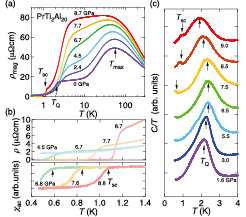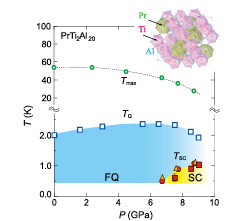Pressure-Induced Heavy Fermion Superconductivity in the Nonmagnetic Quadrupolar System PrTi2Al20
Uwatoko and Nakatsuji Groups
Unconventional superconductivity (SC) with a variety of exotic characters such as anisotropic superconducting gap, large critical field and effective mass, reentrant SC, FFLO SC, etc. has attracted much attention in condensed matter physics. Since most of these unconventional superconductors have been found near a magnetic quantum critical point (QCP), where the magnetic ordering temperature is suppressed to zero due to the Kondo effect, the interesting question is what would happen near the QCP of orbital order. Although, there have been some theoretical suggestions that orbital fluctuations play an important role in iron based superconductors, it is hard to study experimentally because orbital degree of freedom is strongly coupled with spin and charge degrees of freedom in d-electron compounds. In contrast, pure orbital degree of freedom sometimes appears as a quadrupole moment in f-electron compounds such as nonmagnetic Γ3 state in cubic Pr or U based compounds

Fig. 1. (a) Magnetic part of the resistivity, ρmag, versus the logarithm of the temperature under various pressures. Here, ρmag is obtained by subtracting the resistivity of LaTi2Al20 obtained under ambient pressure from that of PrTi2Al20. (b) Temperature dependence of the resistivity and the ac magnetic susceptibility at low temperatures. A large diamagnetic signal due to the SC transition is observed at a lower temperature, which corresponds to nearly 60% superconducting shielding, estimated by comparing to the diamagnetic signal of lead with almost the same size as the sample of PrTi2Al20. (c) Temperature dependence of the ac specific heat divided by temperature for different pressures. The curves are shifted vertically for clarity.

Fig. 2. Open circles and squares represent the position of Tmax determined from the maximum in the temperature dependence of the resistivity and the ferroquadrupole ordering temperature TQ, respectively. The SC transition temperatures TSC are deduced from the temperature dependence of the resistivity (closed circles), the ac magnetic susceptibility (closed triangles), and the ac specific heat (closed squares), respectively. The inset shows the cubic crystal structure of PrTi2Al20. Cages made by PrAl16 and TiAl12 are indicated in green (larger cages) and purple (smaller cages), respectively.
The cubic Γ3 compound PrTi2Al20 has demonstrated the interplay of a ferroquadrupole order at TQ = 2 K and Kondo effect through the strong c-f hybridization [1]. Furthermore, it exhibits SC at TSC = 0.2 K with the associated enhanced effective mass ~16 m0 [2]. Here we report the discovery of a pressure-induced heavy fermion superconductivity in a nonmagnetic orbital ordering system PrTi2Al20. In particular, we found that the transition temperature and the effective mass associated with the superconductivity are dramatically enhanced to more than 100 m0 as the system approaches the putative quantum critical point of the orbital order [3].
Figure 1(a) shows the temperature dependence of the magnetic resistivity ρmag measured under various pressures. At high temperatures, the Tmax due to the magnetic Kondo effect using the excited magnetic CEF levels decreases with pressure, suggesting that pressure slightly reduces the CEF splitting. At lower temperatures, the quadrupole ordering temperature TQ = 2K at ambient pressure can be traced as a sharp resistivity drop up to P = 4.5 GPa and shows a slight increase with pressure. Surprisingly, above 6.7 GPa, another anomaly was observed at lower temperatures. The resistivity shows an abrupt drop to zero at 0.7 K at 6.7 GPa, indicating the onset of superconductivity. With further increasing pressure, the resistivity drop becomes sharper, and temperature of zero resistance increases up to 1.1 K at P = 8.7 GPa. The observation of a large diamagnetic response in the ac magnetic susceptibility at almost the same temperature as the onset of the zero resistance state indicates that pressure-induced superconductivity is of bulk origin (Fig. 1(b)). To further elucidate the interplay between the superconductivity and ferroquadrupole order, we measured the specific heat under pressure (Fig. 1(c)). At 1.6 GPa, the specific heat divided by temperature C/T shows a peak due to the quadrupolar ordering at TQ ~ 2 K. With increasing the pressure, TQ monotonically goes up to P = 5.5 GPa, however, further increase of the pressure starts broadening and shifting the transition to a lower temperature and instead induces a well-defined subsequent anomaly on cooling associated with the superconducting transition. The superconducting anomaly appears at the temperature in full agreement with those found in the resistivity and ac magnetic susceptibility measurements, providing further evidence for the bulk superconductivity. Pressure-induced evolution of ferroquadrupolar and superconducting phases of PrTi2Al20 is summarized in the temperature-pressure phase diagram (Fig. 2). After peaking at P = 6 GPa, the ferroquadrupole ordering temperature becomes suppressed with significant broadening, indicating the presence of the associated QCP.
At 8.7 GPa, a critical magnetic field Bc2 is estimated to be more than 3 T, which is the highest value among Pr-based heavy fermion superconductors and similar to the case found in the Ce-based heavy fermion superconductors. Our results suggest a generic phase diagram hosting unconventional superconductivity on the border of orbital order, paving a new path for further research on novel quantum criticality and superconductivity due to orbital fluctuations.
References
- [1] A. Sakai and S. Nakatsuji, J. Phys. Soc. Jpn. 80, 063701 (2011).
- [2] A. Sakai, K. Kuga, and S. Nakatsuji, J. Phys. Soc. Jpn. 81, 083702 (2012).
- [3] K. Matsubayashi, T. Tanaka, A. Sakai, S. Nakatsuji, Y. Kubo, and Y. Uwatoko, Phys. Rev. Lett. 109, 187004 (2012).
